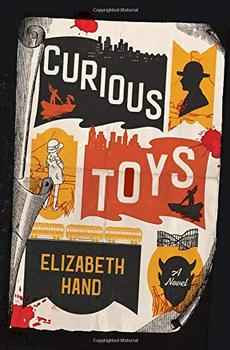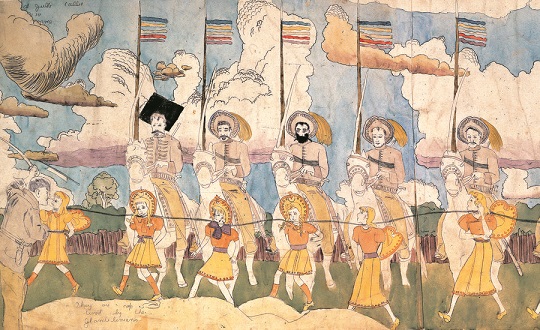Summary | Excerpt | Reviews | Beyond the Book | Read-Alikes | Genres & Themes | Author Bio

This article relates to Curious Toys
 In Curious Toys, the main character, Pin, investigates the murder of a young girl in the Riverview Amusement Park in Chicago in 1915. Only one other person witnessed the girl's disappearance, a strange, shambling man named Henry Darger. Pin is fictional, but Darger is based on a real person who became famous posthumously as an artist and writer.
In Curious Toys, the main character, Pin, investigates the murder of a young girl in the Riverview Amusement Park in Chicago in 1915. Only one other person witnessed the girl's disappearance, a strange, shambling man named Henry Darger. Pin is fictional, but Darger is based on a real person who became famous posthumously as an artist and writer.
Henry Darger was born in Chicago in 1892. When he was four years old, his mother died giving birth to a baby girl, who was immediately put up for adoption. The separation from his sister is believed to have deeply affected Darger. He did not get along well with other children growing up, and was often violent with them. At age eight, he was placed in a boy's home where he lived for four years before being transferred to the Asylum for Feeble-Minded Children in Lincoln, Illinois. This asylum was known to be corrupt, and it's likely that Darger suffered abuse during his time there. When he was 17, Darger's father's death prompted him to run away from the asylum; he succeeded after his third attempt and walked more than 160 miles back to Chicago. There, he was hired as a janitor at St. Joseph's Hospital where he lived and worked until 1922.
Sometime between 1910 and 1912, Darger began writing what would eventually become The Story of the Vivian Girls, in What Is Known as the Realms of the Unreal, of the Glandeco-Angelinian War Storm, Caused by the Child Slave Rebellion, an epic fantasy story of over 15,000 pages bound in 15 volumes. At some point, he also began creating illustrations for his writing. His process involved collecting old magazines, newspapers and photographs from the trash and making collages, or tracing pictures from these sources onto paper, often going over them in watercolor. One of the lead characters in his tale is Annie Aronburg, who was modeled after a photograph of Elsie Paroubek found on the front page of the Chicago Daily News in May 1911. Five-year-old Elsie had been abducted and murdered, and Darger cut out her picture so he could trace it. His copy of the picture disappeared, however, sending Darger into a panic. He was certain his roommate had stolen it. It is believed that the loss of this picture gave Darger's fantasy story its direction: Annie Aronburg, the leader of the first child slave rebellion, was assassinated by an evil general—named after Darger's thieving roommate—and her death sparked the war between the nations of Abbieannia and Glandelenia.
Henry Darger spent the next six decades working as a cleaner at various Chicago hospitals and keeping to himself as much as possible. He was known to have had one friend during this time, an immigrant named William Schloeder. Darger seemed to like Schloeder enough to include the man in his grand tale, and the two would spend time together socially, even occasionally visiting the Riverview Amusement Park. It's also known that the two wanted to found a Children's Protection Society to find loving families for orphans, although it seems that this plan never came to fruition.
In 1972, Darger, alone and living in a boarding house in Chicago's North Side, asked his landlord Nathan Lerner to help move him into a nursing home. (He had been struck by a car in 1969 and was becoming progressively less mobile.) Lerner obliged, and subsequently recruited his wife and another tenant, David Bergland, to help clean out Darger's old room. The group removed two truckloads of trash before stumbling across Darger's work. In all, they found seven typewritten hand-bound books, thousands of loose sheets of typewritten text, and numerous scrapbooks and journals, along with over 350 watercolor, pencil, collage and carbon-traced drawings. These drawings included 87 large watercolors, some up to nine feet long, bound together into three albums. Lerner, a fairly well-known photographer, recognized the value of these discoveries, and immediately set about preserving them. Bergland went to visit Darger to talk about his work, but unfortunately, Darger had become almost completely uncommunicative by that time and simply responded to Bergland's inquiries with a short, "Too late now."
Henry Darger died within a few months of moving into the nursing home, leaving his work unknown to any but the Lerners and Bergland. As artists, curators and writers would visit Nathan Lerner to discuss his photography, he began to share Darger's work, and word eventually spread of this fantastical masterpiece. Darger's popularity grew throughout the art world, and in 1977, the first show of his creations took place at the Hyde Park Arts Center in Chicago. Today, Darger is one of the most famous figures in the realm of outsider art, defined as art created by those who are self-taught. Most of Darger's artwork is currently housed at the American Folk Art Museum and the Museum of Modern Art, both in New York City, but pieces can be found in museums and collections across the world. Furthermore, Darger's 15-volume story about the Vivian sisters is thought to be the longest known work of unpublished fiction.
Elizabeth Hand drew inspiration from Darger's earlier years in Chicago when crafting her depiction of him for Curious Toys. In his personal writing, Darger claimed that he would do anything to protect young children, and this sentiment motivates him to help Pin, Hand's protagonist.
For more on Henry Darger, click on the video to watch the documentary film In the Realms of the Unreal, directed by Jessica Yu.
Illustration by Harvey Darger, courtesy of Artspace
Filed under Books and Authors
![]() This "beyond the book article" relates to Curious Toys. It originally ran in November 2019 and has been updated for the
September 2020 paperback edition.
Go to magazine.
This "beyond the book article" relates to Curious Toys. It originally ran in November 2019 and has been updated for the
September 2020 paperback edition.
Go to magazine.
Your guide toexceptional books
BookBrowse seeks out and recommends the best in contemporary fiction and nonfiction—books that not only engage and entertain but also deepen our understanding of ourselves and the world around us.